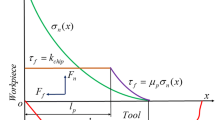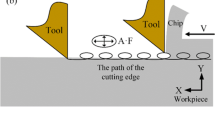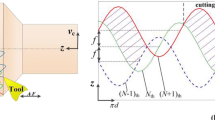Abstract
The purpose of this study was to investigate the effects of the cutting and vibration parameters on the machining performance of 7075-T651 aluminum alloy in an unidirectional ultrasonic vibration cutting. Simulation experiments were performed using the AdvantEdge finite element analysis software. The results showed that as the cutting speed and feed rate increased, the cutting force and cutting temperature of the ultrasonic vibrations in the x- and y-directions increased. As the amplitude and frequency increased, they decreased accordingly. The highest temperatures of the rake and relief of the tool were located 0.01–0.02 mm from the cutting edge. With the change in the cutting and vibration parameters, the residual stress curve had a “spoon-shaped” distribution. When the cutting parameters were increased, the magnitude of the residual stress and the depth of the layer increased to a certain extent. With the increase in the vibration parameters, the change in the residual stress value of the ultrasonic vibration in the x direction was small, whereas the residual stress value of the ultrasonic vibration in the y direction increased accordingly. y-direction ultrasonic vibration and conventional cutting experiments were performed on the workpiece. The simulation values of the y-direction ultrasonic vibration cutting agreed well with the experimental values. At the same time, compared with conventional cutting, the ultrasonic vibration cutting exhibited a greatly reduced cutting force and cutting temperature.













Similar content being viewed by others
References
Wang B, Li XB, Liu J, Jiang H (2018) Comparison of atmospheric corrosion behavior of Al-Mn and Al-Zn-mg-cu alloys in a tropical coastal environment. Mater Corros 69(7):888–897
Zhang YQ, Jiang SY, Zhu XM, Zhao YN, Shan DB (2017) Influence of heat treatment on complex-shape rotating disk subjected to isothermal precision forging. J Mech Sci Technol 31(1):141–147
Cao GP, Song RG (2018) Microstructure and properties of ceramic coatings prepared by micro-arc oxidation on 7075 aluminum alloy. Mater Res Express 5(2)
Burns JT, Jones JJ, Thompson AD, Locke JS (2018) Fatigue crack propagation of aerospace aluminum alloy 7075-T651 in high altitude environments. Int J Fatigue 106:196–207
Arrazola PJ, Özel T, Umbrello D, Davies M, Jawahir IS (2013) Recent advances in modelling of metal machining processes. CIRP Ann-Manuf Technol 62(2):695–718
Muhammad R, Maurotto A, Roy A, Silberschmidt VV (2012) Hot ultrasonically assisted turning of β-Ti alloy. Procedia CIRP 1:336–341
Patil S, Joshi S, Tewari A, Joshi SS (2014) Modelling and simulation of effect of ultrasonic vibrations on machining of Ti6Al4V. Ultrasonics 54(2):694–705
Sofuoglu MA, Cakir FH, Gurgen S, Orak S, Kushan MC (2018) Numerical investigation of hot ultrasonic assisted turning of aviation alloys. J Braz Soc Mech Sci Eng 40(3):122
Cakir FH, Gurgen S, Sofuoglu MA, Celik ON, Kushan MC (2015) Finite element modeling of ultrasonic assisted turning of Ti6Al4V alloy. Procedia Soc Behav Sci 195:2839–2848
Sofuoglu MA, Cakir FH, Gurgen S, Orak S, Kushan MC (2018) Experimental investigation of machining characteristics and chatter stability for Hastelloy-X with ultrasonic and hot turning. Int J Adv Manuf Technol 95(1–4):83–97
Dong GJ, Zhang LM (2019) Investigation on grinding force and machining quality during rotary ultrasonic grinding deep-small hole of fluorophlogopite ceramics. Int J Adv Manuf Technol 104(5–8):2815–2825
Biswas S, Alavi SH, Sedai B, Blum FD, Harimkar SP (2019) Effect of ultrasonic vibration-assisted laser surface melting and texturing of Ti-6Al-4V ELI alloy on surface properties. J Mater Sci Technol 35(2):295–302
Kang D, Zou P, Wu H, Duan JW, Wang WJ (2019) Study on ultrasonic vibration–assisted cutting of Nomex honeycomb cores. Int J Adv Manuf Technol 104(1–4):979–992
Liu JJ, Jiang XG, Han X, Gao Z, Zhang DY (2019) Effects of rotary ultrasonic elliptical machining for side milling on the surface integrity of Ti-6Al-4V. Int J Adv Manuf Technol 101(5–8):1451–1465
Zhang XY, Zhang DY, He S, Jiang XG (2017) Influence of depth of cut on elliptical ultrasonic vibration cutting mechanism. Acta Aer Ast Sin
Eynian M (2015) Vibration frequencies in stable and unstable milling. Int J Mach Tools Manuf 90:44–49
Pei L, Wu HB (2019) Effect of ultrasonic vibration on ultra-precision diamond turning of Ti6Al4V. Int J Adv Manuf Technol 103(1–4):433–440
Zhang XY, Sui H, Zhang DY, Jiang XG (2018) Study on the separation effect of high-speed ultrasonic vibration cutting. Ultrasonics 87:166–181
Lv DX, Huang YH, Wang HX, Tang YJ, Wu XC (2013) Improvement effects of vibration on cutting force in rotary ultrasonic machining of BK7 glass. J Mater Process Technol 213(9):1548–1557
Tabatabaei SMK, Behbahani S, Mirian SM (2013) Analysis of ultrasonic assisted machining (UAM) on regenerative chatter in turning. J Mater Process Technol 213(3):418–425
Zhou M, Hu LH (2015) Development of an innovative device for ultrasonic elliptical vibration cutting. Ultrasonics 60:76–81
Maurotto A, Wickramarachchi CT (2016) Experimental investigations on effects of frequency in ultrasonically-assisted end-milling of aisi 316l: a feasibility study. Ultrasonics 65:113–120
Johnson GR, Cook WH (1985) Fracture characteristics of three metals subjected to various strains, strain rates, temperatures and pressures. Eng Fract Mech 21(1):31–48
Rice JR, Tracey DM (1969) On the ductile enlargement of voids in triaxial stress fields∗. J Mech Phys Solids 17(3):201–217
Jung JW, Lee SE, Hong JW (2019) Experimental and numerical investigations of high-speed projectile impacts on 7075-T651 aluminum plates. Materials 12(17):2736
Gao HJ, Zhang YD, Wu Q, Song J, Wen K (2018) Fatigue life of 7075-T651 aluminium alloy treated with vibratory stress relief. Int J Fatigue 108:62–67
Funding
This study was supported by the National Natural Science Foundation of China (Grant No. 51575289 and Grant No. 51705270), the Key Research and Development Project of Shandong Province (Grant No. 2019GHY112068), and the Natural Science Foundation of Shandong Province (Grant No. ZR2019PEE028).
Author information
Authors and Affiliations
Corresponding author
Ethics declarations
Conflict of interest
The authors declare that they have no conflict of interest.
Additional information
Publisher’s note
Springer Nature remains neutral with regard to jurisdictional claims in published maps and institutional affiliations.
Rights and permissions
About this article
Cite this article
Luo, H., Wang, Y. & Zhang, P. Effect of cutting and vibration parameters on the cutting performance of 7075-T651 aluminum alloy by ultrasonic vibration. Int J Adv Manuf Technol 107, 371–384 (2020). https://doi.org/10.1007/s00170-020-05098-z
Received:
Accepted:
Published:
Issue Date:
DOI: https://doi.org/10.1007/s00170-020-05098-z




